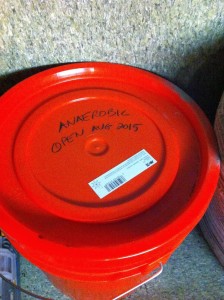You’re a foul one, Mr. Grinch.
You’re a nasty wasty skunk.
Your heart is full of unwashed socks.
Your soul is full of gunk,
Mr Grinch.
The three best words that best describe you,
Are as follows, and I quote
“Stink!
Stank!
Stunk!”
By the time Thanksgiving rolls around, my kitchen compost is beginning to catch up to me. Whereas the alchemical transformation of slimy goo into rich humus seems nearly instantaneous during the summer, due in large part to my mercenary army of soldier flies, as weather cools, my troops begin to mutiny and the slime pile grows. Red wigglers are still at it, but the cold slows them down too, and all the while my holiday pace in the kitchen produces bucket upon bucket of compostable material without a proper guest list to sit down and eat (the compost, that is, not the holiday meal). Christmas is a-coming, as they say, and that means even more feasting…maybe even some Who-ville roast beast! But with all that feasting comes more and more compost, all at a time when fewer and fewer creatures are available to help.
Temperature is the one factor that limits insect, annelid, and microbe alike, and so long as one imagines compost as an outdoor activity and if one lives around or north of the 45th parallel, then the compost pile is going to hit the brakes during winter. This holiday season, however, I have been generously expanding my image of what composting can be and how I might take advantage of a nearby, year-round tropical zone….that being the inside of my house. Not wanting to create a 3×3 or larger aerobic pile in the basement, nor wanting heaps of straw or woodchips inside, I had to think smaller. Something containable. Sure, I could do worms in buckets, but that’s passé. Call me Grinch greedy, but I wanted to be a little bolder, a little more innovative, perhaps flex the risk muscle a little more.
I have often wondered and recently read more about anaerobic composting. If you are an ordinary U.S. citizen, then I expect your lip curled slightly upon reading that word anaerobic, or maybe you went into full nose wrinkle. In our culture, anything anaerobic is nasty, vile, stinky, and putrid. It’s the GRINCH of the compost world, the compost situation that everybody wants to avoid. Of course, anybody’s home that has a septic system has an anaerobic composter, but somehow, perhaps through the familiarity of usage, the word septic seems more….antiseptic! And most aerobic compost pile makers, though they try their hardest to get Carbon/Nitrogen ratios correct and to get the right amount of moisture for their aerobic pile, actually wind up getting a poopy pants award at some point in the process, as some part of the pile gets gooey and nasty smelling for a time. So in one form or another you have probably already joined the anaerobic club. What I’m doing here is just making my tacit consent for anaerobes explicit.
Anaerobic composting is the easiest kind: throw a bunch of stuff together, make no attempt to get ratios between brown and green correct, and just wait a bit longer than usual… with no backbreaking turning,in fact, with no effort at all. That ease is counterbalanced by an enormous defecit – the potential for smell hell. If I could somehow harness the ease of the process and wall off the damage, I would be on my way to full-bore, year-round composting with barely any time invested in the process. The benefits seemed to vastly outweigh the risks, so I bit. I’ve launched a trial, but let me say it’s just that – a trial. I have an escape plan should things go bad, and I’ll outline that later.
The extent of my experiment: All I did was to stuff about three days’ worth of my kitchen sink compost bucket into a larger 5 gal Home Depot pail (get the lid….you’ll see why in a minute). I packed the stuff down in the bucket with a spare piece of 2×4, then poured water over the entire thing until all the air had bubbled up. I took pains to make sure the lid snapped on quite well, and then I LABELED the bucket in the following manner: ANAEROBIC, do not open until August 2014.
 |
| I mislabeled the lid to read Open August 2015 instead of 2014. Maybe that was my unconscious giving me a grace period to avoid the potentially overwhelming effects of a time miscalculation. |
Placed in a completely out of the way space in my basement, I now need to do nothing for the next 8 months and let a whole range of micro-organisms, including the methanogenic Archaea (living things older than bacteria), do their work, happy to be free of oxygen, which to some of them is pure poison! The book I have been consulting on the process is The MiniFarming Guide to Composting by Brett Markham, and in it he discusses all the various compounds, with wonderfully evocative names like scatole (crap smell) and cadaverine (dead body smell), that are generated as by-products of the anaerobic process. These nose-pinching products are in the end absorbed by the water or transformed into something else, because, as with well-finished aerobic compost, the final product of anaerobic composting is said to be rather pleasant smelling. His one warning, ” Do not disturb the water until the process is finished,” sounds like something out of Harry Potter or the Lord of the Rings, and clearly there are demons and evil magic lurking nigh at hand during many stages of this dark-arts process. I’ve heeded all the warnings. My water-topped buckets of temporary putrescence are safely stashed under a work bench in my seed room.
OK, the escape plan. There are two different scenarios here because this dangerous indoor compost gambit has the potential to shut down my other innocuous indoor gardening activities if family members get put out by thinking there’s a dead body rotting down in the basement. If I notice even the faintest funky smell issuing forth, I’ve got a door to the outside 20 feet away, and I’ll scurry them out there immediately, praying hard all the while that the rubber gasket inside the lid holds for the transport. Then outside I can just let them sit undisturbed for a year or so, where they will do their thing, only more slowly due to cooler winter temps. If someone else in the family notices some funkiness, I will gather all the family members upstairs, have them hold hands in a circle, start to sway, then launch into a rousing chorus of “Fah Who Foraze, Dah Who Doraze”. Then I will slip away while they are all singing and filled with goodwill and sneak the buckets outside as described above, quickly returning to welcome Christmas and all the other good energies, not to mention smells, of the season!
Oh, speaking of bucket gaskets, if you think Fah Who Foraze is the result of my bursting a mental gasket, please see the following to get up to speed on the Grinchy cultural reference: http://christmas-specials.wikia.com/wiki/Welcome_Christmas

